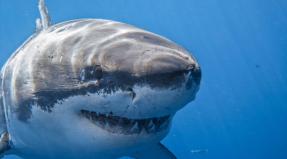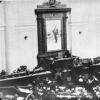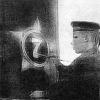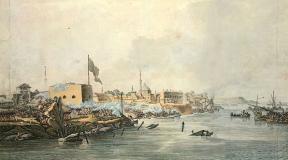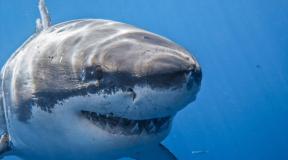The Great Patriotic War is under water. Type "C" IX-bis series submarine IX-bis series
Steady overcoming failures by the S-12 crew
But let's go back to the autumn of 1942, when the third echelon of our brigade covered the entire length of enemy communications in the Baltic with combat influence. Never since the beginning of the war have there been so many Soviet submarines at sea as at this time.
I would like to dwell on the C-12 campaign, directed, as already mentioned, to the eastern part of the Baltic, where the convoy routes that delivered supplies from Germany to Army Group North ended.
The new boat had a crew that had not yet been fired upon (“not bombed,” as submariners sometimes said) and lacked agility. But a group of Red Navy men and senior officers who had been on military campaigns were transferred to the S-12 in advance - this always helped newcomers to submarine warfare get used to it faster. It was also decided that the navigator of the 1st division, captain-lieutenant A.A. Ilyin, and, as an additional watch commander, who was at the disposal of the brigade commander, captain-lieutenant L.A. Loshkarev, in the recent past a civilian sea captain, would go on this trip.
And since the mechanical engineer S-12 was diagnosed with tuberculosis (he hid the disease, and during the blockade winter it worsened), the brigade commander asked (precisely asked) to replace him for this campaign with engineer-captain-lieutenant Viktor Emelyanovich Korzh. Korzh was listed as a backup to the division mechanic and was not the first time used for such unforeseen replacements. The commander of the S-12 received a mechanical engineer who had already proven himself to be the best in a combat situation.
Commander of the S-12 submarine Vasily Andrianovich Turaev
The commander himself, captain-lieutenant V.A. Turaev, according to the conviction of division commander E.G. Yunakov (with which our headquarters also agreed), did not need support for his first military campaign. Like Grishchenko, he had an academic education, and began commanding a submarine on the Black Sea even before the academy. Serious and taciturn, who liked to sit quietly at a chess game in the wardroom, Vasily Andrianovich Turaev belonged to people who are constantly learning. Preparing for a military campaign, he in-depth studied the experience of other commanders, especially those who had visited the area assigned to him.
Getting out to the open sea was not easy for the boat. The crossing of the Gulf of Finland dragged on for several days. First, the S-12 was attacked by an anti-submarine aircraft. The damage caused by bomb explosions also affected one of the battery groups, where later, during a new ascent, a short circuit occurred and a fire broke out, with which the submariners fought for an hour. It is not difficult to imagine what the appearance of the enemy at this time would mean.
And on the further path to the mouth of the bay, S-12 came across a net. Not where it happened with D-2, but to the west. The boat got out of it quite quickly. Here the network was different and apparently had a signaling purpose: the crew heard slight explosions overboard, probably not bombs, but special cartridges. Soon, as one would expect, the sonar picked up the noises of approaching boats. Over three dozen bombs exploded over the boat, which did not have time to move away from the net, but was at great depth.
New damage was added to the previous ones. We had to fight against the flow of water into the central control room through a depressurized drive of one of the kingstons. And at the top the boat was guarded by boats. Fortunately, a storm arose, forcing them to eventually leave. It is possible that the enemy boatmen, not hearing any sounds from the boat, considered it sunk.
Repairs at sea, larger or smaller in volume and complexity, have become commonplace in submariner combat campaigns. “Favorite” places for repairs have also appeared in various areas of the sea. For example, submarines operating in the Danzig Bay or to the west went to the Stolpe Bank for repairs (on modern maps - the Lawica-Slupsk Bank). Enemy ships avoided it, for fear of landing on the rocks, and therefore it was possible to “knock” there without much fear that the boat would be discovered. Serious repairs are always associated with noise that travels far across the sea. But there were no such “secluded places” in the Gulf of Finland. And yet, the crew of the S-12 had to eliminate the consequences of bombing and a fire in the battery pit while still in the bay.
I will add that the sea water that penetrated into the boat soaked her battery with a supply of food. The cereals were salted, most of the sugar died...
Only eight days after leaving Kronstadt, Turaev reported that he was in the area assigned to him, which included the approaches to Memel, Libau, and Vindava.
There was quite an intense movement of ships here, but the convoys huddled close to the shore, almost never going beyond the isobath of ten-meter depths, where it is impossible to maneuver in a submerged position. At the same time, the fairways and approaches to the ports were guarded by anti-submarine ships. More than once, Turaev, having started an attack, was forced to stop it: it turned out to be impossible to hit the target.
Failures followed the boat for a long time. There were later attacks that were carried out to the command “Fire!”, but the torpedo fired, it seemed, did not explode, and perhaps passed under the keel of a shallow-diving target. In one case, the commander of the S-12 decided to catch up with the transport on the surface and sink it with artillery. However, this too failed: the shells that were in the fenders of the gun became damp, and the others did not have time to be delivered from the battle cellar.
The commander of the boat and the political commissar of the ship, senior political commissar F.A. Ponomarev (he went on a campaign as a military commissar, and returned as a political officer: in October 1942, the institute of military commissars was abolished) tried to prevent prolonged bad luck from undermining the faith of the crew, who had not yet had combat successes into your weapon. They were helped by experienced submarine commanders who took part in the campaign and knew a lot of instructive lessons from the brigade’s combat experience. Ponomarev later noted that in the compartments they listened with great interest to the living stories of engineer-captain-lieutenant V.E. Korzh about how failures plagued other crews at sea, and what happened next depended primarily on how confident the sailors remained in their abilities , fighting spirit.
Turaev's innovative attacks
Meanwhile, the situation in the area became increasingly unfavorable. The submarine was repeatedly discovered, and this alerted the Nazis, which entailed an increase in the activity of anti-submarine forces.
But the tenacity of the S-12 commander in searching for the enemy, his ability to maintain the will to win in the crew, were eventually rewarded. Three weeks after arriving in the designated area, Turaev won his first victory - he sank the German transport Edith Bosselman (the name was established much later). He tried to hit another ship from the same convoy, but the torpedo did not hit this target.
A week later, more significant success was achieved. The torpedo attack, which resulted in it, was later studied by many of our commanders. She could serve as an example of very bold and at the same time deeply thought-out command actions in difficult conditions of coastal shallow waters.
At that time, Turaev had, perhaps, completely exhausted the limits of what was possible; he took a considerable risk, considering it justified, because he felt the crew’s training had increased during the campaign. It was not for nothing that the commander, moving further to the sea, where there was enough depth, persistently trained the crew of the central post, shooting the torpedo tubes with air specifically so that the young boatswain learned to hold the boat with horizontal rudders at the decisive moments of the attack.
The attack carried out by S-12 on October 27 deserves to be discussed in more detail. A convoy consisting of five transports, including very large ones, guarded by five patrol ships, was discovered during daylight hours not far from Cape Akmenrags between Libau and Vindava. The ships sailed in a wake column, keeping as close to the shore as their draft allowed. The lead ship was a multi-deck motor ship, probably made from former passenger liners. This is what Turaev set as his main goal. The main one, but not the only one.
After S-12 returned to base, it turned out that the silent and thoughtful Vasily Andrianovich had long been nurturing an idea that arose in him while analyzing the attacks of other commanders. The idea seemed applicable when attacking convoys, where transports move in a wake column (or ledge), and boiled down to the following.
The submarine should take such a position that it would be possible to fire a torpedo or two at the lead ship, turn it a few degrees (or wait a few seconds, keeping the same course) and, continuing a slightly extended salvo, hit the next one. Some commanders had already managed to hit not one, but two targets during an attack on a convoy, but this was either just a happy accident or the result of a quick reaction to the current specific situation. Turaev planned his “double” in advance. And even in unsuccessful attacks (which he meticulously analyzed) he found confirmation that his plan was feasible.
Captivated by a premonition of success in battle, Turaev went to break through the convoy's security in order to shoot from a shorter distance. Everything was made very difficult by the shallow water. And it’s not about the fact that there was nowhere to “dive” from the guards guarding the transports if they started chasing the boat. The depth was simply not enough to maneuver normally underwater. Moments before the salvo, the commander was informed:
- Under the keel - zero!
This was the echo sounder reading. The boat was almost crawling along the ground. But Turaev brought the attack to an end, and the torpedoes came out at the expected time. The first, aimed at the lead vehicle, and eight seconds later - the second, intended for the ship following it. Shooting from a distance of 4–5 cables, the boat commander decided that one torpedo was enough for each target.
And he hit both targets! But it was still necessary to break out of the ring of enemy warships, into which the boat entered, breaking through the guards of the convoy. She remained unnoticed until the salvo. However, the release of torpedoes makes the boat lighter, and abruptly extinguishing buoyancy in such shallow water is dangerous: you can hit the ground hard. In addition, before the salvo, Turaev had to reduce the speed to the limit, otherwise the targets would have been outside the angle of attack, and it became almost impossible to keep the boat at the required depth.
The S-12 logbook testified that during the circulation after the release of the second torpedo there was a moment when the depth gauge in the central post showed 3 meters. In other words, the entire cabin appeared above the water. Let it be for just a few moments, but this is enough for the guards guarding the convoy to rush along the trail of the boat.
And yet the pursuit was late, probably due to the confusion caused by the surprise attack on the enemy and the defeat caused to the convoy. As recorded in the logbook, the boat dropped its first bomb only 12 minutes later. During this time, the boat managed to move to a deeper place. The bombing ended with the forty-second bomb. The boats must have used up their ammunition. The S-12 did not receive any particularly serious damage, and got off easier than a month ago in the Gulf of Finland - the bombing was more accurate there.
The reports of the hydroacoustic, which found the direction of the noise of their propellers, helped to evade the attacks of the boats. The commander also relied on acoustics when approaching the convoy, when the situation almost did not allow the use of a periscope.
The Sovinformburo reported on the combat success of Turaev’s crew, as usual, in an impersonal form: “With our ships in the Baltic Sea...” Moreover, reports of two transports hit by torpedoes within one minute were divided and included in reports on different days. This happened because the commander of the S-12 saw, when he raised the periscope for a second, how one transport was sinking, the sinking of which he could confidently report after breaking away from the enemy and surfacing, although the explosion of the second torpedo was clearly heard on the boat.
After some time, the S-12 returned to Cape Akmenrags, and the results of the attack were clearly visible (they were visible, thanks to the shallow water), not only by Turaev himself, but also by the commanders whom he invited to the periscope. Mechanical engineer Korzh even made a sketch: the masts and part of the pipe of one transport were sticking out of the water (there was not enough depth to submerge completely), another ship was lying on its side.

Seven victories are marked on the fence of the submarine's conning tower
The bold and skillful Turaev attack was carried out in coastal waters, where during the previous campaign enemy ships seemed beyond the reach of most of our commanders. Now the commander and crew were able to “get” them there, even though they had already been in position for a month, but they were on their first combat campaign!
This could serve as one evidence of how the general level of combat skill of submariners increased during the war. All the more confidently one could expect new combat successes from submarines whose deckhouses were decorated with “Stars of Victory.”
Before the war, a star painted on the wheelhouse with one or another letter in the center was a sign of superiority in a certain type of combat training. Now, developing this tradition, they legalized a star with a number indicating the number of enemy ships and vessels sunk by the boat.
The teams were proud of these insignia. The very act of inserting a new number into the star after a successful campaign became an honorable task, and was entrusted to one of those who had distinguished himself.
Three victories for Travkin
One of the oldest Baltic "Pikes" - Shch-303 - also increased its combat score. Its commander, Captain 3rd Rank N.V. Travkin, reported about new victories from the area north of the island of Gotland. First, about the sinking of a large transport, the lead in a convoy heading to one of the Finnish ports.

Transport "Aldebaran", sunk by the submarine Shch-303
There was no need to look for this target - the convoy itself went to the boat, which surfaced at night to charge the battery, and the commander only had to maneuver so as to attack from the darker part of the horizon. Having estimated that the head transport of thousands was twelve tons, the prudent Travkin did not spare two torpedoes for such a target, and then, by his own admission, he reproached himself for not using one - both hit the target. The security guards tried to pursue the boat, which had gone into the depths, but the bombs did not explode very close and did not cause any damage to it. It is easier to break away from the enemy at night.
In the following days, Travkin carried out two more successful attacks. One was notable for the fact that it took place in the fog, and the commander was largely guided by hydroacoustic reports. Another attack - at night, on the surface - ended with a spectacle that was probably remembered for the rest of their lives by those who were able to see the Pike before the urgent dive, when everything around was illuminated by a gigantic flash of flame, and the sinking two-pipe transport went as if it were not in the water. and in a sea of fire. It became clear that a cargo of ammunition exploded on the ship.

The submarine Shch-303 is moored in the Merchant Harbor of Kronstadt, having returned from a military campaign with three victories
"Pikes" of the older generation
From another submarine of the “older generation” Shch-307, a report came about another combat success achieved in the Åland Sea. This “Pike” distinguished itself a year ago. Then, under the command of Lieutenant Commander N.I. Petrov, the first of our submarines sank the German U-144. Now the submarine Shch-307 was commanded by an old Baltic captain of the 3rd rank, Nikolai Onufrievich Momot. The ship he sank at the end of October was subsequently identified as the Finnish transport Betty-X.

Commander of the submarine Shch-307, captain 3rd rank Nikolai Onufrievich Momot
The successes of the “Pike” “old ladies” were somehow especially pleasing. They left the stocks when our Navy was just beginning to gain strength. Having sailed a lot, they then gave way in the battle formation to new boats, and they themselves became training boats. But when necessary, they were able to fight successfully, and have already proven their reliability many times.
Submarines vs submarines
In order not to reveal themselves, the submarines reported from the sea by radio only the most important things and very briefly. About leaving the bay or arriving at a position - with a conditional signal, about a victory - without details, about everything else - only if there is an urgent need to report something to the command.
In the second half of October, such a need arose for Travkin, Momot, and other commanders. They went on air to report on encounters with enemy submarines at their positions. The commanders knew that they had to notify us about this without delay.
Shch-303 met with the enemy boat under very tense circumstances: hydroacoustic I.S. Mironenko reported the noise of its propellers when the commander of the “Pike” began maneuvering to attack the detected convoy. Captain 3rd Rank Travkin did not interrupt the attack, although he had reason to believe that someone else’s boat was preparing to attack his “Pike”. The acoustician was ordered to take bearings both on the convoy transports and on the boat, and the navigator was ordered to continuously monitor its position in relation to ours.
The task was not to let the enemy get ahead of you. Travkin managed to complete the attack and, having gone to depth, broke away from both the surface pursuit and the enemy submarine. But meeting her was hardly accidental. Most likely, the enemy boat was deliberately lying in wait for ours at its position.
The report from the Shch-307 made us think about the same thing. The “Pike” of Captain 3rd Rank N.O. Momot, after the sinking of the Finnish transport, almost collided in poor visibility with an alien submarine that was in its position (Finnish, as it later turned out), and the next night it was attacked by it, but managed to evade the launched torpedoes and go to depth.
All this happened on the same days when our S-7, Lisin’s ship, was sunk by a submarine.
This is how a new threat to our submarines emerged, which not only did not exist before, but did not manifest itself particularly acutely (let alone on a massive scale), and the sharp increase in which we, admittedly, did not foresee. We did not pay much attention to boat-versus-boat operations (which occupied a huge place in the training of the world's fleets in the post-war years). Our naval science has not yet dealt with this essentially.
Further developments confirmed that the Germans and Finns began to send their submarines to the sea specifically to fight ours. And their boats found themselves, in comparison with ours, in an advantageous position: they were not threatened by surface anti-submarine ships and aircraft, there was almost no mine danger for them (their barriers are known, but our mine “cans” are few), batteries could be easily charged in skerries or just off the coast. Nothing prevented enemy submarines from setting up ambushes for ours, lying in wait for them at the approaches to ports, at communications centers or in battery charging areas. This could only be countered by increased vigilance, heightened vigilance.
After the first signs of increasing activity of enemy submarines, a radiogram went on the air and was rehearsed for several nights, warning our commanders about this. The headquarters advised them, if possible, not to charge the batteries on clear nights, to try to use fresh weather for this, when rough seas drown out the noise of diesel engines, to carefully listen to the horizon with hydroacoustics before ascent, and to maneuver in short alternating courses when charging.

Submarine Shch-311 on the Tallinn roadstead
These tips probably helped someone. But the enemy submarines, I repeat, had many advantages. And they were so active (this became clear after the war) that they sank more than one of their own boats, mistaking them for Soviet ones. And our losses in that late autumn were not limited to Lisin’s boat.
As a result of an attack by an enemy submarine, our Shch-305 under the command of Captain 3rd Rank D.M. Sazonov, who had previously sailed on the Malyutki, was lost in the Åland Sea. Shch-306 (commanded by Captain-Lieutenant N.I. Smolyar), returning from Pomeranian Bay, where it sank the German transport Elbing-IX, also did not reach the base. And this, perhaps, was not her only military success in that campaign, but we did not learn about others. The fate of these “Pikes” was also shared by the Red Banner Shch-311, which in 1942 was commanded by captain 3rd rank A.S. Pudyakov.

Dmitry Mikhailovich, Sazonov Anisim Stepanovich, Pudyakov Nikolay Ivanovich Smolyar
True, the cause of death of Shch-306 and Shch-311 could have been a mine explosion, since we did not have reliable information about what happened to them. But it is likely that they were also ambushed by fascist submarines.
Happy return S-12
An incident that was then unsolved occurred with the submarine S-12, the story of which I interrupted by describing its remarkable torpedo attack at Cape Akmenrags. On the way to the base, when the boat was approaching the mouth of the Gulf of Finland on a very dark night, the S-12, while on the surface, experienced a strong blow to the hull from something metal. The boat tilted, and then a series of blows passed under the keel from bow to stern, and something tangibly touched the propellers. No damage was found at that time.
Subsequently, when examining the underwater part of the hull, it turned out that one and a half meters of the forged stem had been torn out. A collision with, say, an enemy patrol boat, of course, could not leave such a “mark.”
After the war, the inquisitive Viktor Emelyanovich Korzh, now a retired captain of the 1st rank, found a hint of the solution to that case. In the list of German submarines killed in the Baltic, he found a mention that one of them, U-272, had gone missing in approximately that area at that time. It is possible that she fell, sailing at shallow depths, under the stem of our “eska”.
That S-12 campaign lasted two months. Almost five thousand miles remained behind the stern of the boat, more than sixty lines of minefields were crossed. But serious trials still awaited her at the very end of the return journey. Having already crossed a third of the Gulf of Finland, the boat approached the meridian of Tallinn. Minreps began to grind along its sides again - another obstacle was being overcome. But passing under anchored galvanic impact mines, leaving them far enough above, had long become commonplace, and the commander was not afraid of bottom mines here, since the depths exceeded those at which the Germans had placed them.
And yet the boat blew up. The explosion that suddenly shook it, as a result of which many mechanisms were damaged and the tightness of the hatches was broken, was, by all indications, the action of an antenna mine, which had not been detected in that place before. The crew dealt with the water entering the compartments and ensured the boat was able to continue moving. As more than once on this voyage, the most proactive organizer of the fight for the survivability of the ship was mechanical engineer V.E. Korzh.

Viktor Emelyanovich Korzh in the central post leads the fight for the survivability of the submarine
An hour later there was a new explosion overboard, causing new damage. So the S-12 “discovered” a barrage of antenna mines unknown to us at the Nargen-Porkkalaud anti-submarine line created by the enemy.
But in order for headquarters to find out about this dangerous place, the boat had to get out of there. And among the mechanisms that failed during the second explosion was the gyrocompass. Turaev had to navigate the ship, guided by echo sounder readings and noticeable differences in the depths indicated on the map. Where the boundaries of the barrier were and how to maneuver so as not to catch another explosive antenna, only intuition could tell the commander. This is how the last obstacles were overcome.
And then, at the edge of the area controlled by our patrols, the boat had to lie on the ground for more than half a day, waiting for the storm to subside: it broke out in such a way that the boats could not go out to meet Lavensari in order to guide her behind the trawls.
In 1942 they hardened themselves and learned to fight
With a very noticeable general complication of the situation at sea, the difficulties of crossing the Gulf of Finland increased even faster. In the fall, cases of OVR ships exploding by mines, providing submarine passage between Kronstadt and Lavensari, became more frequent. But most of the mines with which the enemy replenished his barriers were antenna and bottom anti-submarine mines.
And yet there were not so few successful crossings of the gulf. The recommendations of the headquarters, constantly adjusted, and their own experience helped many commanders break through all obstacles. For the fourth time during the campaign, captain 3rd rank I.V. Travkin crossed the bay in his Shch-303, presented after this campaign to the guards rank. The “Pikes” of Captain 3rd Rank N.O. Momot and Hero of the Soviet Union Lieutenant Commander E.Ya. Osipov broke through to Lavensari unharmed.
Osipov's actions in the Danzig Bay area were successful. The crew of the Red Banner Shch-406 opened the combat account of the campaign by sinking the rather large Mercator transport. Then two more enemy ships were sent to the bottom.
Andrei Mitrofanovich Stetsenko loved, if circumstances permitted, to meet the boat returning from the sea in Kronstadt, and to listen there to the commander’s first report on the details of the campaign. The boat usually stayed for some time in Kronstadt, was not transferred to Leningrad immediately, and in such cases I learned all the most important things about it first from the brigade commander who returned from there.

Transport "Bengt Sture", sunk by submarine Shch-406
Stetsenko also shared his first impressions of the people, how he saw the commander and crew, who spent many weeks in extreme mental and physical stress, more than once looking death in the eye.
The reader can already imagine what tests the fortitude and courage of the submariners were subjected to during that campaign. To the increased dangers and the usual hardships of long voyages on submarines, the cold in the compartments was added in late autumn. The boat crews were well equipped, unlike in the thirties. The top watch wore comfortable kapok pea coats and trousers, which were quite warm and had great buoyancy. If you find yourself in the water, you won’t be pulled to the bottom.
In the compartments they served in warm underwear and fur vests. But this was still not enough if the compartments were not heated. And it was rarely possible to use electric heating pads, which in principle made it possible to maintain a tolerable temperature: difficulties with surfacing to charge the batteries forced them to strictly conserve their energy. Often there was no place to warm up even for the top watch that had changed. In addition, on some boats, at the end of a protracted voyage, the crew did not eat very well: in order to stay longer in position, they also saved food.
All this affected people, as did the fact that the team did not see the sky and the sun for many weeks. It’s good that we had the opportunity to recuperate after the campaigns in the brigade rest house on Kamenny Island, created by the care of flag doctor Tikhon Alekseevich Kuzmin, in a relatively calm, rarely shelled area of Leningrad.
But the pale, haggard submariners were not oppressed or depressed. Everyone who met the boat on Lavensari or in Kronstadt, who later came to board it in Leningrad, felt the high spirit of the personnel and pride in what was done at sea. The crew went through a huge school for such a campaign, which was different in 1942, and returned not only more skillful, but also more self-confident. This happened especially noticeably on boats going out on a military campaign for the first time. In a month and a half, people became different, having received the hardening that usually only comes from long voyages.
“There is no price for such teams,” Stetsenko repeated more than once.
Farewell, beloved city
I myself have rarely seen boats in Kronstadt. More often I accompanied them there when I was able to personally check their final readiness for the trip after loading ammunition, re-demagnetizing the hull, checking trim and other actions preceding a long voyage. And I remembered how people went to sea.
And now a submarine appears before my eyes, departing from the pier of Merchant Harbor. The Red Navy man, who was selecting mooring lines on the aft superstructure, straightened up with a cable in his hands, looked at the harbor, at Kronstadt, and suddenly sang softly:
- Farewell, beloved city, we are leaving for the sea tomorrow...
This song was born in besieged Leningrad and was immediately loved. But I have never heard anyone sing it with such feeling. In the submariner’s voice there was both aching sadness for his native shore, which he looked at, perhaps for the last time, and the hope of still seeing him again, and the determination not to flinch at anything, not to let the commander and comrades down.
On every boat leaving for the west, they knew from which crew, those who had left earlier, had not heard from for a long time, and from which they had already stopped waiting for them. At the end of the campaign, which also spanned November, our losses began to increase. But the submariners, as always, and perhaps even stronger than always, strove to go to sea, seeing it as their duty. Of the submarines that went out on their second major voyage of the campaign, at least two were able to be prepared for this only because their crews, together with factory specialists, were able to repair the damage received during the first voyage faster than expected.
Divisional and flagship specialists persistently sought participation in the campaigns. And everyone went to sea with faith in the surmountability of the obstacles created by the enemy, in the combat success of the ship and the commander.
The mysterious disappearance of Shch-304
The last in the third echelon to be launched into the Gulf of Finland were Shch-304 under the command of Captain 3rd Rank Ya.P. Afanasyev, the boat that opened our combat account in June of 1942, and L-3 Captain 2nd Rank P.D. Grishchenko, who also went to sea during this campaign.
Sailors of the Baltic Fleet discovered a sunken submarine from the Great Patriotic War in the Gulf of Finland.
As the press service of the Western Military District reported to the website, during the study of archival documents by officers of the Baltic Fleet, the estimated coordinates of the site of the death of the Soviet submarine S-12 in the Gulf of Finland in the area of Bolshoi Tyuters Island were obtained.
When examining the bottom in this area using modern search equipment, the crew of the sea minesweeper "Alexander Obukhov" discovered a sunken submarine at a depth of 70 meters. Upon additional inspection of the object, it was found that the appearance and armament corresponded to the Soviet IX-bis "C" series boats.
As experts noted, the lack of data on other submarines that died in this area allows us to assume with a high degree of probability that the location of the sinking site was the submarine S-12.
Currently, it is planned to conduct exercises during which the final identification of the detected submarine will be carried out using special equipment.
S-12 is a Soviet diesel-electric torpedo submarine of the IX-bis series from World War II. Laid down on October 20, 1937 at plant No. 112 in Gorky under slipway number 246. Launched on April 20, 1938, officially entered service on July 30, 1941.
In September-November 1942, the boat made one 62-day voyage, which was accompanied by numerous difficulties due to breakdowns of mechanisms, poor training of personnel, bombing from Finnish ships and aircraft following oil trails on the surface. During this campaign, S-12 made all nine of its torpedo attacks and damaged two transports. On October 21, a single torpedo with 14 cables damaged the ship Sabine Howaldt, its rudder and propellers were torn off, one vacation passenger died, but the transport remained afloat. On October 27, the Malgache transport was damaged by one torpedo; it was taken into tow, but after five hours of towing it landed on the ground near Libau, being out of action for several months. During the reverse crossing of the Gulf of Finland, the boat was blown up twice by the anti-sweeping tubes of anchor mines. Arriving at the base with heavy damage, the S-12 completed the voyage, which became the longest among Soviet boats during the entire war. The commander was awarded the Order of the Red Banner.
On July 30, 1943, the C-12 set out on a mission in an attempt to break through anti-submarine minefields and nets. No news was received from the boat, and it was one of five submarines that died in 1943 during stubborn attempts to break out of the Gulf of Finland.
submarine IX-bis series
Laid down on October 25, 1937 at plant No. 112 (Krasnoe Sormovo) in Gorky (Nizhny Novgorod) under construction number 246. On April 20, 1940, the submarine was launched, on July 24, 1941, it entered service and on July 30, 1941, it entered service Red Banner Baltic Fleet.
The beginning of the Great Patriotic War "S-12" met under the command Turaev Vasily Adrianovich as part of the Submarine Training Brigade in Kronstadt. The submarine was preparing for sea trials. The ship's technical readiness level was 90%. On August 30, 1941, the boat was included in the 1st division of the 1st brigade of the Red Ban Baltic Fleet submarine. In August, the submarine was prepared for the transition to the North, but in September, after the Germans blockaded Leningrad, the transition was canceled, and the S-12 was returned to combat-ready condition. Since the ship did not pass all the required tests, the S-12 did not take part in the initial period of the war and spent the first war winter in Leningrad. On December 11, while parking near the Palace Bridge, an artillery shell exploded 15 meters from the left side of the submarine. The fragments pierced the lining of the main ballast tank No. 2 and broke the ventilation pipe.
The summer of 1942 was spent practicing combat training tasks. “S-12” set off on its first combat mission only on September 19, 1942 (position No. 3 in the Memel-Libava region). Instead of the sick commander of the BC-5, the backup of the divisional mechanic of the submarine brigade, engineer-captain 1st rank V.E., went out to sea on board the submarine. Korzh, who left memories of this campaign (see V.E. Korzh “Margin of Safety”. Military Publishing House, 1966). The transition to Kronstadt was completed relatively safely. Enemy artillery fired at the caravan, which included the S-12, but thanks to a timely smoke screen, not a single shell hit the target. On the evening of September 19, the submarine headed for Lavensari, and on the morning of September 20, the S-12, accompanied by minesweepers, reached the diving point and began crossing the Gulf of Finland. Having successfully passed under a minefield near the island of Gogland and north of the island of Ruuskari, the submarine surfaced to charge its batteries by the evening of September 20. At 18.45, 7 miles west of Gogland Island, the S-12 was attacked by a Finnish aircraft (captured SB type), piloted by Erk Birger. The bomber was spotted too late. An urgent dive did not save the submarine from damage. Two depth charges dropped from an aircraft that exploded near the wheelhouse disabled 32 (out of 64) battery cells. (According to other sources, the shutdown of the bow group of batteries is associated with a fire caused by spilled electrolyte during overnight charging). Hunters called to the scene of the collision found an oil trail on the surface of the water and believed that the submarine had been sunk.
On the afternoon of September 22, 7.5 miles southwest of the Kalbodagrund lighthouse, the submarine, according to the submarine's crew, fell into an anti-submarine network and was attacked by patrol boats VMV-2 and VMV-12, which dropped 40 depth charges on the submarine . The pursuit continued, but the submarine did not suspect that an oily trail was trailing behind it, showing the enemy the location of the ship. It was bombed by four Finnish SB aircraft and two German Arados with Estonian crews. The patrol boats VMV-15 and VMV-16 dropped the entire stock of depth charges on the submarine.
On the night of September 26, “S-12” completed crossing the Gulf of Finland, and reported to the base about its successful breakthrough. On September 26 and 27, the submarine was off the island of Fore, conducting crew training, and only on the morning of September 28 did it arrive at the designated area near the Uzhava lighthouse.
The first contact with the enemy took place on September 29, but the attack failed because the destroyers accompanying the convoy forced the submarine to dive. The next day, C-12 moved to the Pappensee lighthouse, where it observed enemy convoys several times, but was never able to attack, since the fog limited visibility. During the day, the submarine failed to fire torpedoes at the battleship Schlesien, which was escorting the destroyers - the covers of the stern torpedo tubes, jammed during the bombing while the boat was crossing the Gulf of Finland, did not open. (According to German data, at the same time in this area the ships of the 24th flotilla of minesweepers conducting control trawling were attacked by an unknown submarine).
On October 5, northwest of Memel, “S-12” attacked a transport from a convoy. Due to the delay in executing the “li” command, the torpedoes missed the target. The RO-25 transport (former Dutch Gordias, 1,632 GRT) was attacked.
On the morning of October 6, the submarine fired four torpedoes one by one at the ship (it turned out to be the German fishing trawler Viking), but all of them either sank or passed under the target. After surfacing, the S-12 tried to shoot the target with a 100-mm gun; after two misfires, an enemy patrol boat was discovered from the boat; the submarine was forced to dive; the patrolman did not pursue the boat. On the evening of October 8, near the Uzhava lighthouse, a submarine tried to attack a single transport, but the boatswain was unable to keep the ship at periscope depth and “sank” the boat. The moment for the torpedo salvo was lost.
Success came only on October 21, when the S-12 attacked a convoy, which, according to the boat commander, consisted of three transports and four escort ships. According to the enemy, the convoy consisted of the transports "Sabine Howald" (5.956 GRT), "Bremerhaven" (5.355 GRT), "Neudenfels" (7.838 GRT), the rescue ship "Peter Wessel" and the former Dutch "Alkaid" (5.483 GRT), under escorted by patrol ships "Vp-310", "Vp-311" and "Vp-313". Two single torpedoes hit the Sabine Howald transport, which was transporting vacationers from Finland to the Reich. The enemy did not observe the torpedo tracks, but immediately began preventive bombing. The rescue vessel began towing the damaged vehicle. Soon the security of the convoy was reinforced by approaching minesweepers. This time the Germans managed to save and repair the damaged ship; she was killed by a mine in the North Sea on May 11, 1944.
On October 27, “S-12” was again successful. At Cape Steinorth, the submarine attacked a convoy consisting of the transports Mar del Plata, Malgas, Gordias, Ariadne, the hospital ship Rügen, the rescue ship Peter Wessel and the tug Capelle. The ships were guarded by patrol ships "V-1707", "V-1708", "Vp-303", "Vp-304", "Vp-305" and "Vp-311". The torpedo hit the stern of the Malgash transport (6.903 GRT), which was transporting Wehrmacht vacationers from Finland. The Germans tried to tow the damaged steamer, but it landed on the ground 2.5 miles from Libau. The ship was raised a month later and managed to survive the war, sinking off the coast of Somalia in 1967 while flying the Greek flag. German patrolmen counterattacked the boat, dropping 44 depth charges on it. 
October 27, 1942. The ship "Malgache" after being hit by a torpedo from the submarine "S-12".
On the morning of November 9, with the permission of the command, the submarine began returning to base. On November 11, the boat was blown up twice by anti-sweeping devices, resulting in damage to the hull and instruments. By the evening of November 18, 1942, the S-12 arrived safely in Kronstadt, completing the longest cruise of a Soviet submarine during the Great Patriotic War (62 days). In 1,190 running hours, the boat covered 4,960 miles, 1,774 of which were underwater.
The submarine spent the winter of 1942-1943 in Kronstadt.
On the night of May 24, 1943, “S-12” moved to Lavensari to prepare for a breakthrough to the Baltic, but access to the sea was postponed, and the submarine returned to Kronstadt. On July 10, Turaev was transferred to the Northern Fleet and appointed commander of the M-108 submarine. On July 21, captain 3rd rank became commander of S-12 Bashchenko Alexander Arkadievich(previously commanded the submarines “S-5” and “S-4”).
On the night of July 29, “S-12” left with Lavensari on its last trip. The submarine was to conduct reconnaissance in the area of enemy network barriers, and, if they were forced, operate at the mouth of the Gulf of Finland and the Sea of Åland. Communication with the submarine was maintained until August 1, when it reported charging off Cary Island. “S-12” did not get in touch again. 














"S-12" at the bottom. Photo by Janne Suhonen.
Sonogram; Stern 45 mm gun; Bridge; GON compass binnacle; Propeller screw.
Torpedo loading hatch; Bow torpedo tube; Stern; Noise direction finder antenna; Platform of a 45 mm gun.
The location of the fracture is in the bow; Upper deck; Mine anchor in the stern; Left propeller; Horizontal steering wheel.
In 2016, the submarine was found, and on September 1-2, 2018, it was finally identified and examined by divers of the Reconnaissance Diving Team and members of the Finnish Divers of the Dark. The wreck of the submarine lies 8 miles north of the island of Naissaar, on the edge of the main channel through the Gulf of Finland at a depth of about 90 m. The submarine was blown up by the UMA mine of the Nashorn 2a barrier east of the Walrus anti-submarine network. The submarine's hull is torn into two parts 30-40 and 20 m long; the second compartment, completely destroyed by the explosion, is missing. The stern part of the boat has been preserved up to the front wall of the wheelhouse, the bow part from the stem to the torpedo-loading hatch. The bow gun is missing; a torn piece of iron, which was the edge of the gun platform, lies nearby. The detonation site in the wheelhouse area is under the ground, and on the bow side it is a light and durable body twisted into a pipe. The force of the explosion knocked out the torpedo-loading hatch and even the upper control room. The stern of the submarine is slightly raised above the ground, the rudders are in the “zero” position. Directly under the screws there is a mine anchor and a mine repair. Probably, “S-12” died while moving away from the network, since it was oriented in the east, northeast direction; the boat reached the net and, realizing that it could not be overcome, went back to the east. Based on the nature of the damage to the S-12, its crew died instantly. Along with the ship
A Soviet submarine that perished during the Great Patriotic War has been discovered in the Baltic, the press service of the Russian Baltic Fleet reported.
“The crew of the newest sea minesweeper “Alexander Obukhov” of the Baltic Fleet discovered a sunken submarine in the Baltic Sea. Presumably, the USSR Navy submarine “S-12”, which perished during the Great Patriotic War, was found,” the message says.
The site of the death of "S-12" in the Gulf of Finland is located in the area of Bolshoi Tyuters Island.
“When examining the seabed in this area using modern search equipment, the crew of the Alexander Obukhov discovered a sunken submarine lying on an even keel at a depth of 70 meters. With an additional inspection of the submarine and subsequent comparison of the data obtained with the tactical and technical characteristics of Soviet submarines boats, it was established that the appearance and armament correspond to the Soviet boats IX-bis of the “C” series,” the press service said in a statement.
The press service also reported that an exercise will be held in the Baltic, during which the final identification of the discovered submarine will be carried out using special equipment.
The Baltic Fleet, in accordance with the decision of the Russian Minister of Defense, is searching for and inspecting warships of the USSR Navy that perished during the Great Patriotic War. S-12 "is a Soviet diesel-electric torpedo submarine. It is believed that the submarine was lost in the summer of 1943 while trying to break out of the Gulf of Finland through minefields.
S-12 was laid down on October 20, 1937 at plant No. 112 in Gorky under slipway number 246. Launched on April 20, 1938, officially entered service on July 30, 1941 under the command of V.A. Turaeva.
On June 22, 1941, the S-12 met as part of a submarine training brigade in Kronstadt for testing. In 1941, she did not go on a hike. In September-November 1942, she made one 62-day voyage, which was accompanied by numerous difficulties due to breakdowns of mechanisms, poor training of personnel, bombing from Finnish ships and aircraft following oil trails on the surface.
During this campaign, S-12 made 9 torpedo attacks and damaged two transports. On October 21, a single torpedo with 14 cables damaged the ship “Sabine Howaldt” (5959 GRT), its rudder and propellers were torn off, one vacation passenger died, but the transport remained afloat.
On October 27, the Malgache transport (6300 GRT) was damaged by one torpedo; it was taken into tow, but after five hours of towing it landed on the ground near Libau, being out of action for several months.
During the reverse crossing of the Gulf of Finland, the boat was blown up twice by the anti-sweeping tubes of anchor mines. Arriving at the base with heavy damage, the S-12 completed the voyage, which became the longest among Soviet boats during the entire war. Commander V.A. Turaev was awarded the Order of the Red Banner.
On July 30, 1943, S-12, under the command of A.A. Baschenko, went on a combat mission in an attempt to break through anti-submarine minefields and networks. No news was received from the boat, and it was one of five submarines that died in 1943 during stubborn attempts to break out of the Gulf of Finland.


